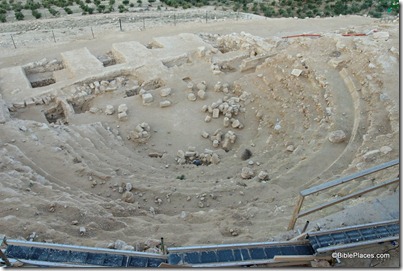In a remarkable archaeological find, the remnants of King Herod’s theater box have been unearthed at the ancient site of Herodium, a sprawling fortress and palace complex built by the infamous king himself. This discovery offers a tantalizing glimpse into the theatrical culture of antiquity and invites us to reconsider the significance of entertainment in Herodian society.
Herodium was not merely a military stronghold; it was a testament to Herod’s grandeur and ambition. As a ruler, he was known for his monumental architectural projects and his desire to connect with both Roman and Jewish cultures. The theater box, a distinct feature in the layout of the amphitheater, signifies more than just seating arrangements; it illustrates the intricate social hierarchies that defined ancient performance spaces. The discovery of this theatrical element urges us to ponder the role that drama and performance played in the political and social fabric of Herodian life.
Imagining King Herod seated in his opulent theater box, one can envision the vibrancy and enthusiasm that would have filled the air as audiences gathered for plays, music, and possibly even political commentary wrapped in theatrical forms. Such a setting not only entertained but also communicated power dynamics. It was in these moments that the king’s authority could implicitly be reinforced through the narratives performed on stage, echoing the zeitgeist of the time.
The significance of the theater box extends beyond mere aesthetics. It reveals facets of daily life in the first century BCE, allowing modern scholars a window into the preferences and values of Herod’s clientele. Were the performances laden with political allegory? Did they reflect the tensions between Herod’s Jewish subjects and his allegiance to Rome? These questions deepen our understanding of the cultural and historical context of the era.
Moreover, this discovery highlights the role of the arts as an agent of unity and division. As audiences gathered, they were engaged in a collective experience, yet the theater also served as a space where class distinctions were pronounced. The positioning of the theater box reflects the physical separation of the elite from the masses below, amplifying the intricate social strata of Herodian society. Visitors to Herodium today can step into this dramatic past, brought to life through the remnants of architecture.
This archaeological treasure also begs a broader inquiry into how the arts influence political narratives throughout history. By examining the interplay between rulers and public performances, one can trace the evolution of power and its representation. Thus, the unveiling of King Herod’s theater box should not only pique interest as a historical curiosity but also provoke a re-evaluation of how we interpret cultural legacies and their implications for contemporary society.
In conclusion, the discovery at Herodium serves as both an artifact of grandeur and a catalyst for deeper philosophical and historical considerations. It encapsulates the complex weave of performance, power, and identity that characterized not only Herodian rule but also the broader tapestry of ancient civilization. As scholars delve into this multifaceted site, the story of King Herod’s theater box continues to unfold, promising further insights into a past that remains as captivating as it is instructive.
